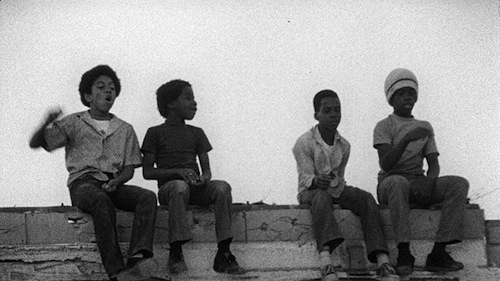|
The Killer of Sheep (1977) Reviewed by: Paula Farmer Directed and Written by Charles Burnett Starring Henry G. Sanders, Kaycee Moore USA, 83 minutes, Black and White A little known, long lost classic thankfully becomes available on DVD after decades of obscurity and then a brief run through art houses in select cities earlier this year. Charles Burnett’s 1973 student film, The Killer of Sheep, is not only a haunting portrayal of black life in inner-city Los Angeles in general, but more specifically of Stan’s life, the film’s protagonist (Henry Gale Saunders). Stan is a disillusioned dreamer who’s becoming more and more detached from friends and family with every day he clocks in at work, a local slaughterhouse. His low-paying job and its cruel and arduous nature takes its toll on him financially, emotionally and psychologically. It becomes increasingly harder for Stan to make ends meet or to justify his existence and he embraces a growing sense of futility. Despite this, his pride keeps the entreaties by friends to a life of crime and infidelity at bay. Stan retreats within himself and finds solace from observing inane objects and non-sensical conversations of others. All this to the dismay of his sympathetic wife who feels overwhelmingly dejected and alienated from their marriage. Interspersed throughout the storyline of Stan’s plight, are bits of unexpected and subtle riffs of humor, effectively portrayed by Stan’s friends and his children’s neighborhood playmates. They entertain themselves with poor kids’ toys and activities of a bygone era- discarded trash in alleyways, holding their breath while standing on their heads contests, and in one astonishing, almost poetic scene, they go unnoticed, leaping from one dilapidated apartment building to another while the grown-ups deal with their daily routines and stresses. What makes this film so special is not just the poignancy of the story, but how it was shot- the look of it, the feel of it. The Killer of Sheep is a quintessential example of a post-modern neo-realism film. If you’ve ever experienced Michelangelo Antonioni’s L’Aventurra or La Notte; Vittorio de Sica’s The Bicycle Thief and Umberto D, you know of which I speak. Like, Killer of Sheep, these are films that examine alienation and in their starkness illuminate the reality of humanity at their core. These are films that make little or no attempt at entertainment, but rather are unabashedly socially didactic and historically accurate and significant. Killer captures a sense of time and place like no other film of that era. Working with an almost non-existent budget of $10,000, Burnett cast mostly family and friends for the film, heightening the feel of reality. Little wonder that upon the film’s completion in 1977 and through sporadic screenings, like at the Berlin Film Festival, it garnered a bit of a following and much acclaim. Enough noteriety to warrant the attention of the Library of Congress, which declared it a national treasure as one of the first fifty on the National Film Registry, and the National Society of Film Critics selected it as one of the “100 Essential Films” of all time. Unfortunately, due to the expense of its music rights, this cinematic masterpiece never got a theatrical release. It had only been seen on poor quality 16mm film at very occasional museum screenings. That is until earlier this year, thirty years after its debut, when after being restored to a 35mm print by UCLA Film & Television Archive, Milestone Films released The Killer of Sheeptheatrically and now on DVD. – George Washington (David Gordon Green) – Ikiru (Akira Kurwosawa) – Europa 51 (Roberto Rosselini)
0 Comments
Leave a Reply. |
AuthorPaula Farmer. Archives
June 2024
Film |

 RSS Feed
RSS Feed